The freshwater prawn (Macrobrachium rosenbergii) is considered a new product in the U.S. and many parts of the world. Because many consumers are not yet familiar with freshwater prawns, it is important for producers to use proper handling procedures to ensure that the product is appealing to consumers.
Prawns kept alive after harvest will not lose quality, though it can be quite challenging to keep large numbers of harvested prawns alive in tanks for an extended length of time. If the animals are not going to be held or sold alive, natural degradation will begin once the animals are killed. The major causes of product degradation after death are the effects of bacteria and/or enzymes. These are the processes that must be controlled or slowed to protect product quality.
Many bacteria come initially from the prawn’s external environment (i.e., the pond water at harvest). Enzymes come primarily from inside the prawns themselves. The enzymes that degrade the product are mainly digestive enzymes located in the prawn’s “head.” These enzymes help the prawn digest its food. After death, these same enzymes can begin to “digest” the prawn’s tail meat if the process is not interrupted. This can cause the tail meat to become mushy. Prawns are much more susceptible to this problem than marine shrimp. However, if prawns are handled properly—including deheading them quickly after harvest—they can be stored as long as or longer than marine shrimp.
Both of the degradation processes (bacterial and enzymatic) are slowed by thoroughly washing harvested Centerprawns and reducing their temperature. So the object is to get the product clean and keep it clean and get it cold and keep it cold. Lowering the temperature slows bacterial growth and reduces enzyme activity. If the prawns are not to be kept alive, chill them thoroughly and quickly. But do not let them sit in water, even ice water. When whole prawns or prawn tails are held on ice, it should be drained ice so that enzymes and bacteria are flushed away from the product.
Specific recommendations for handling freshwater prawns after harvest depend on the product form (e.g., live, whole-on-ice, fresh tails, frozen tails).
Harvesting
Product quality can be affected by the way the animals are treated during the pond harvest process. Prawns should be removed from the ponds in a healthy state and as clean as possible, no matter what the final product form. To accomplish this, thorough planning is required. At least 1 week before harvest, finalize plans for obtaining the necessary equipment and labor. While needs may vary according to site, all equipment necessary for harvesting, washing, grading, processing and storing must be ready.
It is important to determine accurately the time required to drain the pond so that harvest activities can begin promptly when paid workers arrive.
Prawns tolerate harvest conditions best when water temperatures are 70 to 72 °F. If too warm, their metabolism is higher and they can stress (or die) more quickly. Also, warm water holds less oxygen than cool water.
Dissolved oxygen levels should be monitored during pond drawdown; oxygen levels become most critical when prawns are concentrated in the catch basin. Dissolved oxygen should be maintained at ? 5 ppm throughout draining and harvest. Flushing clean, oxygenated water into the catch basin during harvest can be helpful. A small, floating, fountain-type aerator in the catch basin during harvest can help keep the prawns in the best condition possible.
Prawns cannot be efficiently removed from ponds with traps or seines. Even with a properly designed and constructed pond and an efficient seine crew, more than half of the prawns may be left in the pond. Because of this, almost all prawn ponds are designed with catch basins to concentrate the prawns as the water is drained. Catch basins may be internal or external.
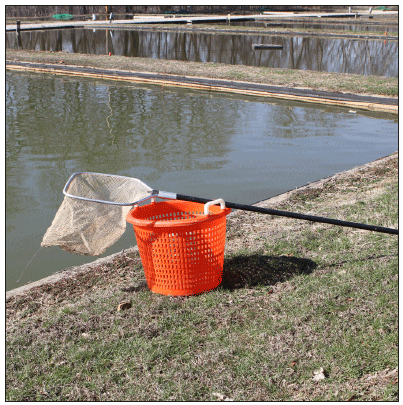
Basic harvesting equipment includes long-handled dip nets, mesh baskets, and scales (Fig. 1). The dip nets should be sturdily constructed with metal handles on the frame throats for grasping heavy loads. Perforated plastic baskets with a mesh of about ½-inch-square will retain prawns but allow water and debris to drain out quickly. If the mesh is too large, the prawn’s claws may break off, which reduces the market value of the whole product. The baskets need strong handles to hold the harvested prawns during transfer to rinsing, holding or transport tanks. Baskets should be filled only one-half to two-thirds full to prevent damage to the prawns.
Interior Basins
Prawns can be harvested by draining the water down and concentrating the prawns into a catch basin inside of the pond at the drain end. Prawns are then removed with a small seine. The catch basin should be about 10 to 15 feet wide with a length about two-thirds the width of the pond (Fig. 2). The catch basin should be 18 to 24 inches deeper than the pond bottom. The pond bottom should slope 1 to 2 degrees to allow water to drain to the catch basin. The drain pipe should be located in the floor of the catch basin at its deepest point. A drain pipe 8 to 10 inches in diameter in a ½- to 1-acre pond will make the pond drain faster and reduce the labor required to harvest the prawns.
Interior basins are less expensive to build than exterior basins but prawns harvested from interior basins are likely to have more mud on them and in their gill chambers. When the pond is drained prawns will hide under any weeds or equipment (such as aerators) in the pond, or in any type of rut or depression they can find. Workers should not walk through ponds leaving deep footprints.
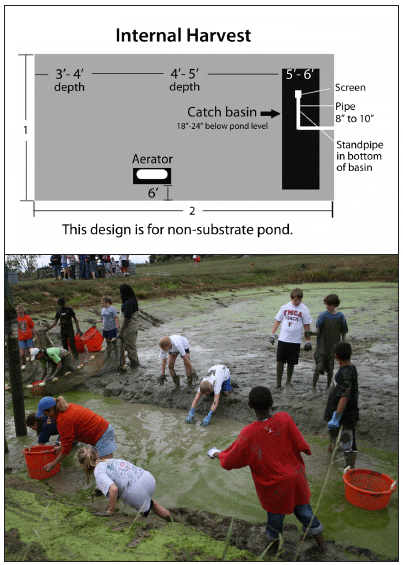
Exterior Basins
Another harvest method is to collect the prawns in a basin outside of the pond as they are flushed out through the drain pipe (Fig. 3). The external collection basin should be large enough to retain the entire harvest of prawns. Make sure the exit pipe out of the catch basin is large enough to allow water to leave easily and not overflow the basin. If possible, water should be routed to a reservoir pond for reuse. A net pen, constructed of heavy seine material and placed inside the basin, with a “sock” that attaches over the drain pipe, works well to contain the prawns. This method of harvest requires an additional source of water for flushing prawns stranded on the pond bottom or inside the drainpipe. Prawns harvested from external basins are often cleaner than those harvested from internal basins.
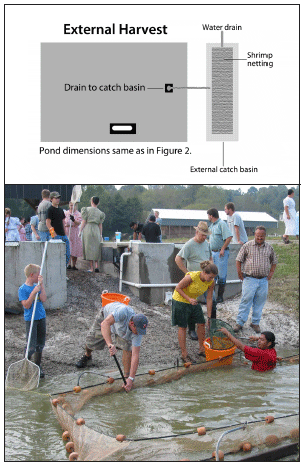
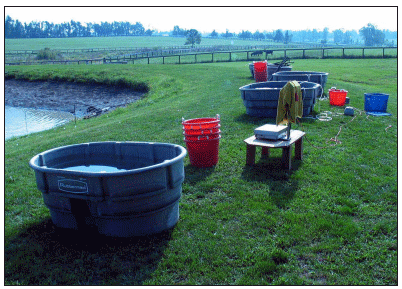
Cleaning and Cooling
Prawns should be moved out of the catch basin and into purge tanks (rinse tanks) as quickly as possible (Fig. 4). These tanks are placed next to the pond and filled with clean water for washing the mud and debris off the animals. It is helpful to have a series of four to eight rinse tanks in a row. Baskets of prawns are dipped sequentially in the tanks and cleared of surface mud, becoming progressively cleaner with each tank. Prawns are then moved to tanks with clean water and aeration where they are allowed to swim freely, removing mud from the gills and under the carapace. About 2,000 to 3,000 gallons of clean, aerated water are needed for each 1,000 pounds of prawns to be harvested.
Live Markets
There is a demand for live prawns, especially in gourmet and ethnic markets. Live prawns sell at wholesale for about $4.00 to $8.00 per pound, while final retail prices are about $10.00 to $22.00 per pound. However, holding and transporting live prawns can be challenging, especially if they were stressed during harvest.
Live prawns must be marketed quickly because significant mortality and cannibalism can occur in holding facilities. If prawns are to be transported by a live hauler, schedule pick-up for the day of harvest if possible, or at most 1 to 2 days after harvest. Keep the tank water temperature at 70 to 72 °F and do not allow the temperature to drop below 65 °F during the night. Tanks should be well aerated and contain enough artificial substrate that each animal has about 1 square foot of surface area. Panels of substrate should be at least 4 inches apart to allow the prawns access to all areas of the tank.
Prawns that have recently molted or are about to molt are likely to be lost to aggression or cannibalism in holding tanks. This loss can be up to 10 percent of the harvested crop, which has a significant impact on profitability. Any animals that appear weak or soft-shelled, or that seem to be approaching a molt, should not be placed in the holding tanks but should be sold whole on-ice or de-headed on-ice, or cooked and consumed.
Market-size prawns that have not been stressed during harvest can be transported in hauling tanks for up to 24 hours, at 1 pound per gallon, with more than 90 percent survival. Successful transport requires reducing the water temperature to 68 °F and providing proper aeration. Adding artificial substrate to the hauling tank does not improve survival. Again, animals must be in good condition before transport. A holding period of 1 to 2 days after pond harvest may be necessary to eliminate weak and soft-shelled animals before transport. It may be beneficial to wait until pond water temperatures cool to 68 to 70 °F before harvesting prawns destined for live markets. Keep in mind that if prawns are intended for live sales it is especially important to aerate the catch basin and have an adequate supply of cool, clean, well-aerated water for holding the prawns before transport.
Pond-bank Sales
Even if prawns are to be sold fresh on the farm, product quality is enhanced if those animals are quickly and humanely killed and their body temperatures lowered as quickly as possible. Both of these objectives are accomplished most efficiently by chill-killing the animals in an ice bath. It is not advisable to place live prawns directly on ice or into a refrigerator because this lowers internal temperatures too slowly.
To properly chill-kill prawns, they are first cleaned in rinse tanks and purge tanks and then placed in the chill-kill tank, which contains clean, clear water with sufficient ice added to create a slurry. About 1 to 1 ½ pounds of ice will be needed for each pound of prawns harvested. Prawns should be left in the chill-kill tank approximately 20 minutes to cool sufficiently. Longer times are not recommended because this can degrade the texture of the tail meat.
To confirm that adequate cooling has occurred, core temperatures of the prawn tails should be measured. This is done by removing one of the prawns from the slurry and inserting a thermometer directly into the center of the tail meat. The insertion site is the joint between the tail and the rear part of the “head.” If procedures are properly followed, prawns will normally chill to a core temperature of 34 to 36 °F within 20 minutes. Adding salt to the chill-kill tank can cause the temperature to drop below 32 °F and speed up the process.
When placing prawns into the chill tank, it is helpful to keep them in baskets or a mesh enclosure. If mixed directly with the ice, weighing prawns for customers will be complicated by ice in the weigh basket.
Once prawns are thoroughly chilled, they can be placed on drained ice for delivery or customer pick-up. Shaved ice is best. The container should be packed with alternating layers of prawns and ice, with the bottom and top layer just ice. The drain must be kept open or the bottom of the cooler perforated so water can drain and prawns are kept above the ice melt. Whole prawns can be held on drained ice for 2 days. Deheaded prawn tails can be held on drained ice for up to 6 days, although Mississippi State University researchers have reported good quality for as long as 12 days.
Fresh-tail Market
While certain markets will pay a premium for live or whole product, other markets insist on tail-only product. Even on-farm purchasers may not be willing to process prawns themselves. For a tail market, all the harvesting, washing and chill-kill steps previously described apply. Then, to dehead, simply grasp the head in one hand, the tail in the other, and pull and twist. If fresh tails cannot be marketed within 5 days of harvest, they need to be frozen. Prawns destined for freezing should receive the same care and attention as those destined for fresh sales. Processed prawns yield approximately 40 to 50 percent tail weight.
Retail prices for prawn tails are about $12.00 to $20.00 per pound. (However, selling whole prawns is usually more profitable than selling processed tails.) In markets where headless shrimp or prawns are both sold, freshwater prawns can be readily distinguished from marine shrimp (family Penaeidae). The freshwater prawn’s second tail segment overlaps the first and third segments on the outside, while in marine shrimp each abdominal segment is overlapped by the previous one (Fig. 5).
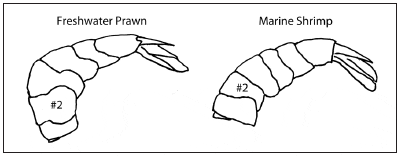
Processing Regulations
To sell deheaded, peeled or value-added prawns one must have processing facilities and follow procedures that meet local health and/or FDA standards. If the products are to be sold directly to the consumer, an approved facility is needed but a HACCP plan is not required. If sold wholesale to a distributor, a restaurant, or via interstate commerce, the processing facility must comply with a food safety plan prepared according to the FDA Hazard Analysis and Critical Control Points (HACCP) program. (More information on HACCP is available in SRAC Publication No. 4900.) Unaltered prawns, such as those sold live or whole-on-ice, are not covered by HACCP regulations unless they are sold across state lines.
Mobile Processing Unit
In Kentucky, prawn processing is done throughout the state in simple on-farm processing facilities or by commercial processors. Producers who lack access to these facilities have a HACCP-approved, low-cost alternative— the state-wide mobile processing unit (MPU) owned by Kentucky State University (KSU). The MPU is approved by county health departments for processing fish, shrimp and other farm-raised animals. No product liability insurance is required of the processor under the management agreement with KSU. Advance reservations and a nominal deposit are necessary to guarantee specific dates. Currently, the MPU costs $100 per day to rent and operators are required to take a one-time training course to learn safe and sanitary operating procedures. The course costs $75, and there is a $50 annual renewal fee.
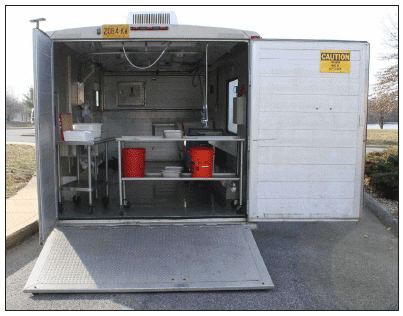
The MPU can accommodate six workers and a manager, with one additional person operating the holding and chill-killing tanks outside of the MPU. The MPU is equipped with a receiving table, three-compartment sink, separate hand washing sink, ice storage bins, a packing table, two ice bath tanks, and two processing tables. It must be located and “hooked up” at a qualified docking station, which consists of a level pad (gravel or concrete), with 220-V, ground-fault interrupted, 50-amp electrical service within 30 feet and an approved water source.
Because Kentucky has only one MPU available, it has primarily served as a temporary arrangement for beginning producers. Most large-scale producers either have their own on-farm processing facilities or hire commercial processors.
Yield
The tail yield of freshwater prawns depends on sex and size. As prawn size increases, the percentage of tail meat decreases. Females yield a significantly larger proportion of tail meat than males, independent of size. The claws of females are small and have a relatively constant relationship to the total weight (2.8 percent). Male claws are larger, and the claw percentage increases with body weight. Thus, in males of 20 g the claws are 4.3 percent of total weight, while in 100-g males the proportion is 14.3 percent. The overall average yield of tail meat in freshwater prawns is lower than that of marine shrimp (48 percent as opposed to 63 percent). However, the yield of edible meat in prawns is greater than in other important crustaceans such as lobsters (36 percent), crayfish (15 percent), and crabs (15 percent), or in fish such as tilapia (35 percent) and catfish (40 percent).
Composition
The chemical composition of prawn tail meat is approximately 76 percent moisture, 21 percent protein, 1 percent ash, and less than 1 percent lipid. Prawns are reported to have lower levels of cholesterol and iodine than marine shrimp. High concentrations of cholesterol have deterred some people from eating shrimp, and iodine is the source of a common allergy related to seafood consumption. Researchers at Mississippi State University reported that the cholesterol content of prawn tail tissue averaged 0.85 mg/g compared to 1.25 mg/g in marine shrimp, while iodine values were 0.14 ppm for mediumsized prawns (30 g whole weight) compared to 0.80 ppm for marine shrimp. With these findings, freshwater prawns might be promoted a Figure 6. A mobile processing unit. s a more healthful product.
Size Grading
Due to a complicated social structure, there will be a large range of prawn sizes in a pond at harvest, and this affects marketing. In some markets, prawns are sold as mixed sizes for a fixed price. In other markets, prices depend on size, and prawns below a minimal size may be considered unmarketable. These prawns may be consumed by the producer or discarded. In tropical regions with a year-round growing season, size variation can be managed by selectively harvesting large individuals. In temperate regions, however, the entire population is harvested at once because of temperature limitations, and 10 to 20 percent of the harvested population may be below market size (less than 20 g). Most small-scale producers in the U.S. market their prawns fresh on the pond bank and do not usually grade them by size. Larger producers, who do not sell their entire crop fresh, typically do some type of size grading during processing. However, most prawn producers grade into only three or four size categories, while many restaurants are more accustomed to the more than ten categories common with marine shrimp.
A significant amount of research has been done on controlling size variation during pond growout. Adding more substrate to growout ponds has been shown to reduce size variation, as has size grading seedstock before stocking. Monosex culture also shows promise. While these management techniques can reduce size variability, they do not eliminate the problem and have not been widely implemented in commercial production.
If U.S. farm-raised freshwater prawns are to be produced on a large commodity scale, and break away from current niche marketing, more consistent size grading will be required. This will likely require a combination of biological management during production and mechanical size separation during processing to achieve the size consistency required by restaurant and retail grocer markets.
Frozen Storage
Deciding whether or not to freeze prawns depends mainly on the length of time between harvest and consumption. If they will not be cooked within 5 days of harvest they should be frozen. Freezing ensures that the growth of microorganisms is stopped and autolytic enzymes become almost inactive. Freshwater prawns have a different muscle structure than marine shrimp and require more care during handling, processing, and frozen storage.
The quality of frozen prawns is largely dependent on the storage temperature and the rate of freezing. The deterioration of prawns caused by microorganisms ceases at temperatures below 14 °F (the operating temperature of most residential freezers). However, enzymatic activity can continue, albeit very slowly, at this temperature. For long-term storage, it is advisable to use commercial freezers with temperatures lower than 4 °F, especially when freezing whole prawns (with the heads intact), as enzymes responsible for protein breakdown are concentrated in the head.
The rate of freezing determines the size of the ice crystals that form in the cells within the meat. If the temperature is decreased too slowly, relatively large ice crystals form. This causes intracellular fluids to leak out of the muscle tissue, thus drying the product and reducing shelf life. If the temperature is quickly decreased from 30 °F to 23 °F, smaller ice crystals form, reducing moisture loss.
Using specialized equipment such as commercial blast or cryogenic freezers will ensure the best quality when freezing freshwater prawns. Cryogenic freezing is recommended for prawn tails. Blast freezing of pre-packaged prawns is recommended for whole prawns to prevent the claws from breaking.
In reality, most small producers use residential freezers to freeze and store prawns. This can affect the texture of the flesh if not done properly. Packaged prawns should be in contact with the base of the freezer or the shelves where the refrigerant liquid passes. Packages should be small. When the thickness of the packages increases, the time required to freeze them thoroughly also increases. Packages must not be stacked upon one another, as this also slows freezing, especially in packages near the center of the stack.
A practical substitute for commercial freezing equipment is a walk-in freezer with wire rack shelves and fans for air circulation. Open exposure and rapid air flow around the product greatly increase the freezing rate, simulating the conditions of a commercial blast freezer. Results can be enhanced by spraying unpackaged product with water during the freezing process to create a protective glaze. Water glazing is often used to protect prawns from freezer burn or desiccation during frozen storage.
Small quantities (1 to 2 pounds) can be frozen in heavy “zipper top” freezer bags. After the prawns are weighed, they are placed in the bags and tap water is added. The bag is then partially zipped closed, leaving a 1-inch gap. Water is squeezed out, and then the bag is zipped fully closed. This leaves the prawns coated in water without having to freeze (or thaw) large amounts of water. Small-scale producers have begun using small plastic clam-shell or sandwich containers for freezing 1- and 2-pound quantities in water. These small containers are more puncture resistant and more easily stacked.
Prawns also can be blanched before freezing. Blanching consists of exposing whole or deheaded prawns to steam or boiling water long enough that the surface is cooked but the center is not. Blanching extends chilled shelf life by deactivating enzymes. It is also a desired product form in some markets as the color is attractive (red) and the process greatly decreases the likelihood of mushiness. For blanching, cook times should not exceed 3 to 4 minutes at 212 °F.
If properly handled and frozen, prawns can be held at temperatures below -4 °F or colder for up to 6 months without noticeable loss of quality. Prawns that have been properly chill-killed, processed, and the tails frozen in water have been stored frozen for more than a year without substantial quality loss. The product should be clearly labeled and dated so that older product is used first.
Proper Thawing
Since some amount of bacterial and enzymatic breakdown occurred before freezing, proper thawing is also an essential step in ensuring the quality of frozen prawns. Prawns should be cooked from a frozen state or after thawing in a refrigerator for no more than 8 hours. Thawing under flowing water or in a microwave is not advised. For head-on product, slow thawing in a refrigerator for less than 8 hours keeps the claws intact but may result in some softening of the tail, especially near the head region. For best results, whole product should be only partially thawed before cooking.
If using prawn tails frozen in a block of water, it is best to remove the frozen block from its packaging and place it in a colander sitting in an empty bowl or pan in the refrigerator. This will prevent the thawed product from sitting in water. If the tails will be cooked immediately, flowing cold water can be used to “quick thaw” the block just enough to separate the tails. Again, only partially thaw the tails. Quality is best if there are still ice crystals in the flesh when the tails go into the pan or the pot.
Repeated freezing and defrosting can produce a mushy product. While this is a common practice with marine shrimp in restaurants, it is a very bad practice with prawns. Educate your buyers! Frozen product should be packaged in such a way that the end user can defrost just the amount needed for each occasion (as with individually quick frozen tails), without having to refreeze the remaining product.
Conclusion
Freshwater prawns are now produced in most states within the southern region. However, many consumers are still not familiar with the product. It is essential that prawns be properly handled so that only high quality product enters the market. In the past, problems with mushy texture, especially with frozen prawns, have been a concern. However, with proper harvesting and postharvest handling, the consistent high product quality of the product can be ensured.




